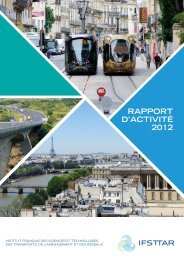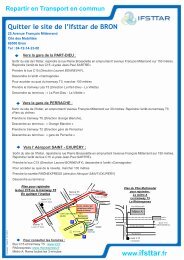french institute of science and technology for transport ... - Ifsttar
french institute of science and technology for transport ... - Ifsttar
french institute of science and technology for transport ... - Ifsttar
Create successful ePaper yourself
Turn your PDF publications into a flip-book with our unique Google optimized e-Paper software.
Research orientation S_Improving road safety <strong>and</strong> modernizing <strong>transport</strong> infrastructure<br />
On the road<br />
From video surveillance to meteorological<br />
observation<br />
In order to locate <strong>and</strong> <strong>for</strong>ecast weather that may disrupt<br />
traffic, <strong>for</strong> example fog, the French meteorological <strong>of</strong>fice<br />
(Météo-France) relies on observations. Risk maps are<br />
then drawn up by combining satellite observations with<br />
observations made on the ground.<br />
The latter are made using a network <strong>of</strong> about a hundred<br />
weather stations spread all over mainl<strong>and</strong> France. Un<strong>for</strong>tunately,<br />
the resolution <strong>of</strong> this system is not sufficient to give reliable<br />
data <strong>for</strong> a very localized phenomenon like fog. For this reason<br />
critical areas such as airports are specifically instrumented in<br />
order to measure meteorological visibility distances.<br />
In contrast with airports, the linear nature <strong>of</strong> the road network<br />
makes this kind <strong>of</strong> instrumentation economically problematic<br />
not to say impossible. However, there is enormous potential<br />
<strong>for</strong> meteorological observations <strong>of</strong> fog on roads as many<br />
<strong>of</strong> them are equipped with video cameras <strong>for</strong> surveillance<br />
purposes.<br />
Raouf Babari’s thesis, which was jointly funded by Météo-<br />
France <strong>and</strong> IFSTTAR <strong>and</strong> directed by IGN, set out to evaluate<br />
this potential.<br />
The outcome is a novel method <strong>for</strong> estimating the meteorological<br />
visibility distance by processing images from convential<br />
roadside cameras, which are inexpensive, robust to lighting<br />
Fog observations using a video camera: (a) an image <strong>of</strong> fog from the Météo-France<br />
instrumented site at Trappes; (b) X-axis: meteorological visibility distance measured<br />
by Météo-France. Y-axis: an estimator based on the average normalized gradients<br />
in the Lambertian zones <strong>of</strong> the image. The model that has been fitted to the data (blue)<br />
has been plotted in red.<br />
conditions <strong>and</strong> effective over a wide visibility range from road<br />
fog to atmospheric pollution.<br />
@ CONTACT<br />
nicolas.hautiere@ifsttar.fr<br />
a<br />
Estimated Contrast (m)<br />
1700<br />
1600<br />
1500<br />
1400<br />
1300<br />
1200<br />
1100<br />
1000<br />
900<br />
800<br />
700<br />
0 5000<br />
10000 15000<br />
b<br />
Meteorologie visibility distance (m)<br />
61<br />
Airport pavement design<br />
With some help from Alizé<br />
The development <strong>of</strong> a new design method <strong>for</strong> airport<br />
pavements, in collaboration with STAC.<br />
Traditionally, the French airport pavement design<br />
methodology is empirical, based on the American CBR (Cali<strong>for</strong>nia<br />
Bearing Ration) method <strong>for</strong> flexible pavements. It uses<br />
the CBR rating to characterize soils <strong>and</strong> applies coefficients<br />
<strong>of</strong> equivalence between different materials. It does not take<br />
account <strong>of</strong> the real configurations <strong>of</strong> aircraft l<strong>and</strong>ing gear or<br />
the actual mechanical behaviour <strong>of</strong> the materials.<br />
The collaborative project between IFSTTAR <strong>and</strong> STAC<br />
(French Civil Aviation Technical Centre) is intended to overcome<br />
these shortcoming <strong>and</strong> develop a new design method<br />
<strong>for</strong> airport pavements. The method is founded on an “aeronautical”<br />
version <strong>of</strong> the IFSTTAR Alizé pavement design s<strong>of</strong>tware<br />
package. As is the case with roads, the design process<br />
involves computing the stresses within the pavement using<br />
a linear elastic model. The main difference relates to the description<br />
<strong>of</strong> the traffic, as in the case <strong>of</strong> the airport pavement,<br />
the damage produced by each type <strong>of</strong> aircraft passing over<br />
the pavement is computed separately. Miner’s law is then<br />
applied to give the cumulative damage. The FICAV database<br />
held by STAC is used to obtain the characteristics <strong>of</strong> different<br />
airplanes. Their speed <strong>of</strong> passage <strong>and</strong> variations in their<br />
transverse position are also taken into account.<br />
A design manual <strong>for</strong> airport pavements which describes the<br />
entire method was drafted in 2011, <strong>for</strong> asphalt pavements.<br />
It is currently being validated by a group <strong>of</strong> experts from the<br />
pr<strong>of</strong>ession (contractors, project owners) <strong>and</strong> is due to be<br />
published at the end <strong>of</strong> 2012. A second version, <strong>for</strong> pavements<br />
with hydraulically bound foundations, is planned <strong>for</strong><br />
a later date.<br />
@ CONTACT<br />
pierre.hornych@ifsttar.fr<br />
ANNUAL REPORT 2011 ifsttar.fr






![Trajectoire le magazine n°3 - Juillet 2012 [.pdf] - Ifsttar](https://img.yumpu.com/30038493/1/190x253/trajectoire-le-magazine-na3-juillet-2012-pdf-ifsttar.jpg?quality=85)

